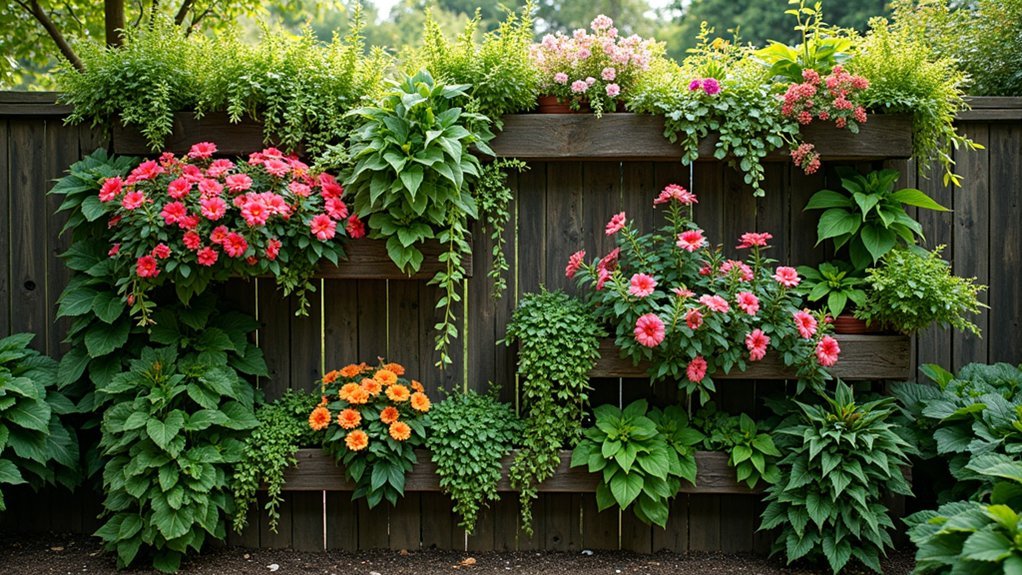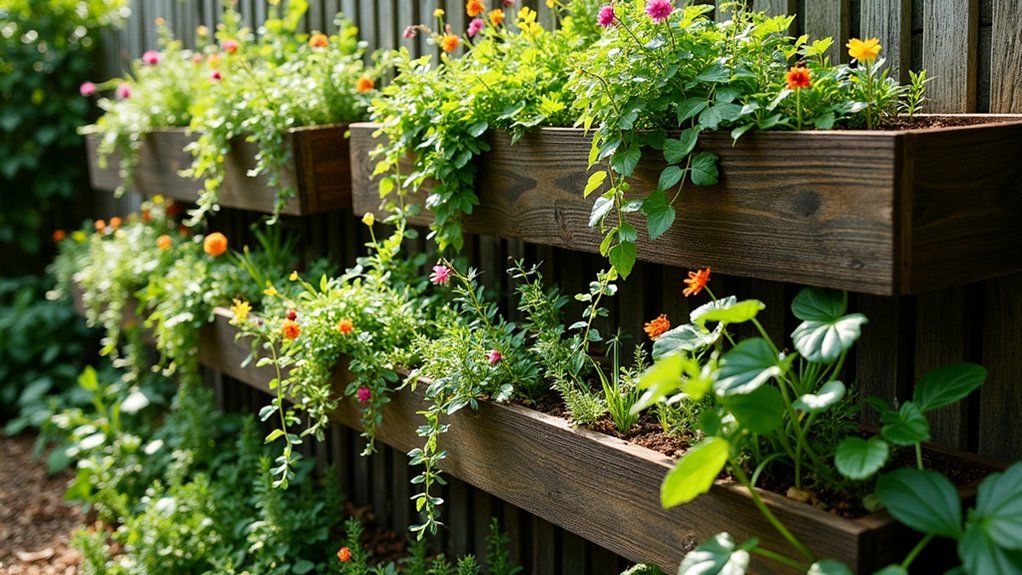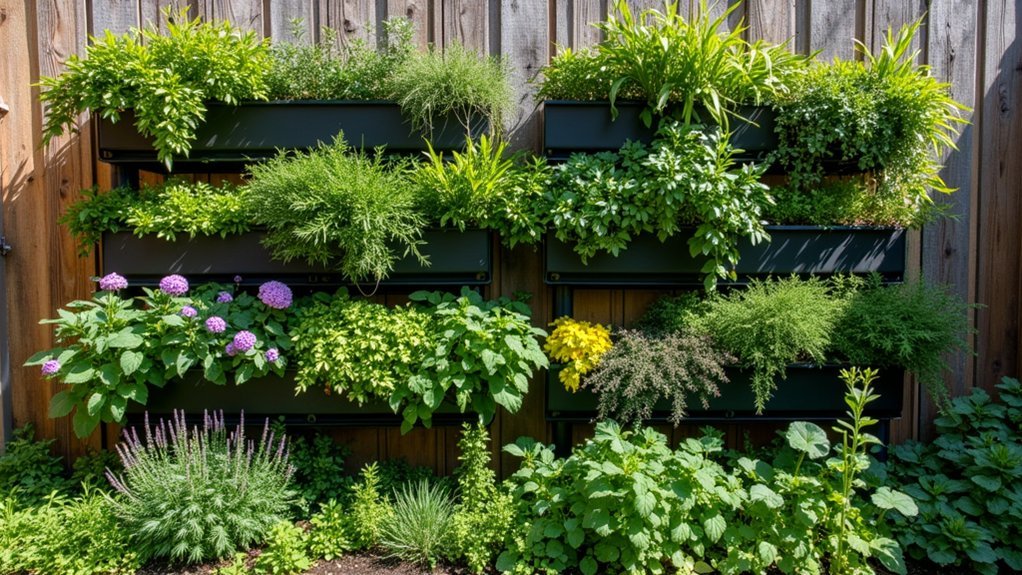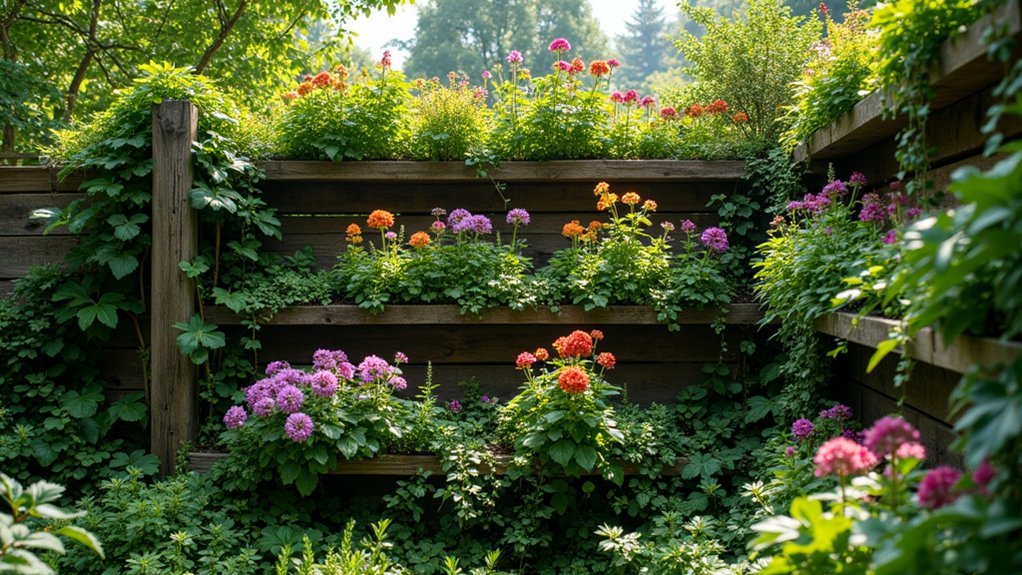Vertical terraced fence gardens thrive with sturdy foundations, proper drainage, and strategic plant placement. You’ll need treated materials that resist moisture damage, layered soil with good drainage, and plants selected for each tier’s unique microclimate. Install drip irrigation systems for efficient watering, and incorporate support structures for climbing varieties. Regular maintenance keeps your garden productive year-round. The combination of thoughtful structural design and biodiversity creates a thriving vertical ecosystem that maximizes even the smallest spaces.
12 Second-Level Headings for “What Makes Vertical Terraced Fence Gardens Thrive?”

Why do vertical terraced fence gardens succeed where traditional gardens might struggle? The secret lies in their tiered design that maximizes growing space while optimizing sun exposure.
Through strategic placement of your wall garden along south-facing fences, you’ll capture maximum sunlight for all plant levels.
Position your vertical garden where it receives southern light exposure, maximizing solar benefits for every tier.
Successful vertical gardening techniques incorporate complementary plant varieties—trailing species cascading downward while others grow upward. This arrangement not only creates visual interest but improves air circulation between plants, reducing disease risk.
Your tiered system also allows for specialized soil composition at different levels. Plants with similar water needs can share the same tier, making maintenance more efficient.
With proper drainage systems in place, you’ll prevent root rot while ensuring each plant receives appropriate moisture—a common challenge in traditional garden beds.
Structural Foundations for Terraced Fence Gardens
Building a vertical terraced fence garden that withstands time and weather requires proper structural foundations from the outset.
You’ll need sturdy posts set in concrete to support the weight of soil, plants, and the entire tiered structure. Selecting treated wood or naturally rot-resistant materials guarantees your garden will endure season after season.
When designing your terraced system, incorporate these essential elements:
- A sloped design that creates distinct levels while facilitating natural water movement
- Built-in drainage systems using perforated pipes to prevent water pooling around plant roots
- Reinforced terracing with wire mesh or landscape fabric to combat soil erosion
Remember that addressing drainage early in your construction process saves you significant maintenance headaches later.
Your structural foundations aren’t just about stability—they’re the invisible heroes that keep your vertical garden thriving year-round.
Optimal Soil Layering Techniques

Ideal soil layering in your vertical terraced fence garden starts with a drainage layer of coarse materials like gravel or rocks at the bottom to prevent waterlogging.
You’ll want to create a nutrient-rich middle zone using a blend of compost, well-rotted manure, and quality potting soil that supports healthy root development.
Finish with proper topsoil retention methods, including a layer of mulch that conserves moisture, suppresses weeds, and helps maintain consistent soil temperature for your plants.
Drainage Layer Foundations
Creating effective drainage layers forms the cornerstone of successful vertical terraced fence gardens, particularly when you’re working with limited space and vertical growing conditions. Proper water management starts with a 2-4 inch layer of coarse materials like gravel or small stones at the bottom of your beds, allowing excess moisture to escape while maintaining ideal conditions for root development.
To guarantee your drainage layer functions effectively:
- Place landscape fabric above the drainage materials to prevent soil from clogging while still allowing water to pass through
- Adjust the thickness of your drainage layer based on the overall depth of your planting bed
- Perform regular assessments of your drainage system to maintain proper soil moisture levels
This methodical approach to soil layering helps prevent waterlogging that can lead to root rot and other plant diseases in your vertical garden.
Nutrient-Rich Middle Zones
Once you’ve established a solid drainage foundation, the nutrient-rich middle zone becomes the powerhouse of your vertical terraced fence garden. This critical layer should be at least 12 inches deep to accommodate developing root systems while ensuring proper aeration.
Create ideal soil structure by implementing lasagna layering techniques—alternating carbon-rich “browns” with nitrogen-rich “greens.” This balanced approach fosters a diverse nutrient profile that supports robust plant growth.
Enhance nutrient availability by incorporating worm castings or well-rotted manure into your middle zones. These amendments stimulate microbial activity, breaking down organic matter into forms plants can readily absorb.
Don’t skip regular soil testing. Identifying deficiencies early allows you to make targeted amendments, maintaining the perfect growing environment.
Your garden’s productivity depends directly on the quality of these nutrient-rich middle zones.
Topsoil Retention Methods
While the nutrient-rich middle zone provides your garden’s foundation, proper topsoil retention forms its resilient outer layer.
Your vertical garden’s success depends on creating a layered system that balances drainage with moisture retention. Mix organic matter like compost into your topsoil to improve structure and provide essential nutrients for your plants.
To maximize your garden’s efficiency:
- Install geotextile fabric between layers to prevent soil erosion while allowing roots to breathe
- Apply a 2-3 inch mulch layer on top to regulate temperature and retain moisture
- Create varying soil depths in your tiered system to accommodate different plant root needs
This layered approach guarantees your topsoil stays where it belongs while maintaining ideal moisture levels.
You’ll conserve water and create the perfect environment for plants to thrive in your vertical space.
Water Management Systems for Vertical Structures

Because vertical terraced fence gardens have limited soil volume, proper water management becomes essential for plant survival and growth.
You’ll need to implement efficient water management systems that address the unique challenges of vertical structures.
Consider installing a drip irrigation system that delivers water directly to plant roots, minimizing waste while maximizing moisture retention.
For terraced designs, gravity-fed systems work exceptionally well, allowing water to flow naturally through each layer.
Enhance your soil with moisture-retaining amendments like coconut coir or water-retaining crystals to improve water holding capacity.
Self-watering reservoirs within your planters can reduce watering frequency and help plants thrive during dry periods.
Remember to regularly adjust your watering schedule based on plant needs and environmental conditions.
Proper monitoring prevents both overwatering and underwatering, ensuring your vertical garden flourishes year-round.
Plant Selection for Different Tiers and Exposures
You’ll need to select plants based on each tier’s specific light conditions, with sun-loving varieties like tomatoes thriving in top sections while shade-tolerant herbs and leafy greens flourish below.
For visual interest, incorporate cascading plants such as strawberries or trailing petunias that can spill gracefully over the edges of your terraced garden.
Don’t forget to take into account root depth requirements, placing deep-rooted vegetables in bottom tiers with more soil while reserving upper levels for shallow-rooted options.
Sun-Loving Top Tiers
When designing your vertical terraced fence garden, the top tiers become prime real estate for sun-loving plants. These upper levels receive maximum sunlight exposure, making them perfect for crops like tomatoes, peppers, and strawberries that thrive in full sunshine.
When planting these areas, remember to:
- Combine various heights and growth habits to maximize vertical space efficiency—pair vining cucumbers with upright sunflowers
- Include culinary herbs like basil and oregano that love sunny conditions and complement neighboring plants
- Space plants adequately to promote air circulation and prevent disease development
Don’t forget to take into account seasonal sun patterns, as taller structures may cast shadows on lower tiers throughout the day.
Strategic placement guarantees all plants receive their light requirements while making the most of your vertical gardening system.
Shade-Tolerant Lower Levels
While the top tiers bask in abundant sunshine, the lower levels of your vertical terraced fence garden present different opportunities with their shadier conditions. These lower tiers are perfect for shade-tolerant plants that thrive with limited sunlight exposure.
| Plant Type | Examples | Light Needs |
|---|---|---|
| Leafy Greens | Spinach, Lettuce, Kale | Partial shade |
| Herbs | Mint, Parsley | Low to medium light |
| Ornamentals | Ferns, Hostas, Astilbe | Deep to dappled shade |
You’ll find vegetables like chard and kale produce impressive yields despite reduced sun exposure. For visual interest, incorporate flowering shade perennials such as bleeding hearts alongside variegated foliage. The textural contrast between broad-leaved hostas and delicate ferns creates dynamic lower tiers in your vertical terraced fence gardens, transforming what might seem like challenging spaces into lush, productive zones.
Cascading Plant Options
Selecting the right cascading plants transforms vertical terraced fence gardens into stunning visual displays that maximize every inch of growing space.
For your vertical garden’s top tier, trailing options like lobelia, ivy, and sweet potato vine create that coveted spilling effect that adds dimension and movement.
When planning your cascading plant options, consider:
- Positioning sun-lovers like succulents, rosemary, and thyme in middle tiers where they’ll receive ample direct sunlight
- Reserving lower tiers for shade-tolerant varieties such as ferns and caladium that thrive in less light
- Adding visual interest with colorful annuals like petunias or pansies distributed throughout the tiers
Remember to arrange plants by height, keeping shorter varieties in lower sections to prevent taller plants from being overshadowed, ensuring your entire vertical garden flourishes with lush, cascading greenery.
Natural Support Methods for Climbing Species
As your vertical garden climbs upward, providing proper support becomes essential for climbing species like peas, beans, and cucumbers. These climbing plants naturally reach for the sky through phototropism, growing toward light sources to maximize sun exposure.
Install sturdy support structures such as cattle panels or wooden trellises that can handle the weight of mature vines and their eventual harvests. These natural support methods not only facilitate upward growth but also improve air circulation around the foliage, reducing disease risk.
Consider companion planting at the base of your climbers—herbs or leafy greens benefit from the partial shade while helping retain moisture.
Don’t forget to regularly prune and train your vines onto supports. This maintenance encourages healthier growth and guarantees your vertical garden remains productive throughout the growing season.
Seasonal Maintenance Strategies

Your vertical terraced fence garden thrives when you master the art of timing your pruning efforts to align with each plant’s dormant phase.
You’ll want to adjust your watering schedule throughout the seasons, reducing frequency during rainy periods and increasing during hot, dry spells.
The secret to perfect pruning lies in understanding that spring-flowering plants should be trimmed right after blooming, while summer bloomers benefit from early spring cuts.
Pruning Timing Secrets
The secret to maintaining thriving vertical terraced fence gardens lies in mastering the art of seasonal pruning. Your timing directly impacts plant health and productivity in these vertical spaces.
Prune perennials in late winter before new growth emerges to promote healthy blooms, while fruit-bearing plants benefit from late summer trimming for improved air circulation.
For vertical gardening success, remember these critical timing guidelines:
- Deadhead annual flowering plants throughout their blooming season to encourage continuous displays
- Trim vining plants during the growing season by removing suckers for enhanced fruit production
- Assess and prune back any overgrowth in late fall to prepare your vertical garden for winter dormancy
Regular seasonal pruning prevents disease, improves aesthetics, and guarantees your vertical terraced fence garden remains vibrant year after year.
Seasonal Watering Adjustments
While pruning keeps your vertical garden in shape, water management determines its survival. Your vertical gardening system requires thoughtful seasonal adjustments to thrive year-round.
During summer’s heat, you’ll need to water every 1-3 days as soil moisture evaporates quickly in terraced setups.
As temperatures cool in spring and fall, reduce watering to once every 3-5 days to match decreased plant needs.
Winter brings dormancy for most plants, allowing you to cut back considerably—often to just once every two weeks, depending on rainfall.
Don’t rely on schedules alone; check soil moisture regularly using a meter or the simple finger test.
Each plant variety has unique hydration requirements, so customize your approach.
Proper watering adaptation to both climate and plant needs guarantees your vertical garden remains vibrant through all seasons.
Biodiversity Enhancement Through Vertical Design
Creating biodiversity hotspots in limited spaces becomes remarkably achievable when you implement vertical terraced fence gardens. The layered structure allows you to cultivate different plants with varying needs, creating a thriving ecosystem in your own backyard.
Your vertical garden’s diverse plant arrangement naturally improves air circulation, reducing pest problems while supporting healthier growth.
For maximum biodiversity benefits:
- Incorporate native plants to attract and sustain local pollinators
- Mix plants with different light and water requirements across terraced levels
- Include flowering species that bloom in different seasons for year-round habitat support
You’ll notice the vertical design not only maximizes your growing space but transforms your fence into a living ecosystem.
This architectural approach to gardening creates aesthetic variety that engages community interest while actively contributing to local ecological resilience.
Space Maximization in Limited Areas

When space constraints challenge your gardening ambitions, vertical terraced fence gardens offer an ingenious solution that multiplies your planting capacity by up to 300%.
By implementing modular shelving and stackable vertical planters, you’ll transform even the narrowest alleyways or tiny yards into productive growing spaces.
Modular shelving solutions unlock growing potential in spaces you never imagined could sustain life.
The tiered structure guarantees each plant receives ideal sunlight—a critical factor in urban environments where light access is often limited.
You’ll find that vertical gardening creates valuable space to grow without expanding your garden’s footprint.
For maximum efficiency, install drip irrigation systems that deliver water directly to plant roots, conserving this precious resource.
Adding trellises and wall-mounted elements helps maximize planting area while creating beneficial microclimates that regulate temperature and reduce wind exposure—turning spatial limitations into advantages for your thriving vertical garden.
Material Selection for Durable Terraced Fences
Selecting the right materials for your vertical terraced fence garden dramatically impacts its longevity and maintenance requirements. When building your structure, focus on durable materials that can withstand the elements while supporting your plants’ weight and growth.
- Treated wood offers excellent value and natural appeal—pressure-treated options resist rot and decay, making them ideal for outdoor garden structures exposed to moisture.
- Galvanized steel provides superior strength for heavier plantings with its corrosion-resistant properties and sleek modern aesthetic that complements various garden styles.
- Composite lumber delivers low-maintenance performance with resistance to fading and splintering, making it perfect for busy gardeners.
Don’t overlook drainage materials like gravel or perforated pipes within your design—they’re essential for proper water management and will prevent soil erosion that could compromise your garden’s structural integrity.
Microclimate Creation Within Tiers
Vertical terraced fence gardens naturally develop distinct microclimates that savvy gardeners can leverage for diverse planting opportunities.
When you design your tiered garden, you’re creating a dynamic ecosystem where each level offers unique growing conditions.
Upper tiers capture maximum sunlight, perfect for vegetables and herbs that thrive in bright conditions. Meanwhile, lower tiers retain moisture longer, supporting plants that prefer humid environments and protecting their root systems from drying out.
You’ll notice how the structure itself alters wind patterns, shielding delicate plants on lower levels from harsh weather.
This tiered approach allows you to strategically position plants based on their specific needs—placing sun-lovers up high while moisture-dependent varieties flourish below.
Integrating Edible Plants With Ornamentals
Beyond creating microclimates, your terraced fence garden offers the perfect canvas for blending functionality with beauty.
By integrating edible plants with ornamental plants, you’ll maximize your vertical garden space while enjoying both visual appeal and fresh harvests.
Shallow-rooted edibles like lettuce and strawberries thrive alongside flowering plants, creating a productive and vibrant display throughout growing seasons.
Meanwhile, companions like trailing nasturtiums and edible pansies add both color and flavor to your meals.
- Plant marigolds between vegetables to deter pests while adding bursts of color
- Position compact herbs like basil and thyme where they’ll receive ideal sunlight yet complement flowering neighbors
- Arrange plants with varying heights and textures for visual interest that also enhances light exposure for all species
Frequently Asked Questions
What Are the Benefits of Vertical Gardening?
You’ll maximize space in small areas while improving plant health through better air circulation. Vertical gardens make maintenance easier, reduce pest issues, increase crop yields, and enhance your space’s aesthetics and biodiversity.
What Are the Principles of Vertical Garden?
You’ll maximize vertical space by using walls and fences, ensuring strong support structures, selecting shallow-rooted plants, maintaining regular care routines, and understanding light exposure for ideal growth in your vertical garden.
Are There Any Drawbacks to Using Vertical Gardens?
Yes, you’ll face frequent watering needs, higher initial costs, limited root space for plants, potential structural concerns, and more complex pest management. Vertical gardens require careful planning and consistent maintenance to overcome these challenges.
What Is the Vertical Gardening Theory?
Vertical gardening theory is your strategy for maximizing limited space by growing plants upward. You’ll increase yield, improve air circulation, and reduce pest issues while creating diverse, sustainable gardens using trellises, walls, and hanging planters.
In Summary
You’ve now got all the tools to create a thriving vertical terraced fence garden. By focusing on strong structural foundations, proper soil layering, smart water management, and thoughtful plant selection, you’ll maximize your limited space. You’ve learned to create microclimates, choose durable materials, and blend edibles with ornamentals. With these principles in place, you’ll transform ordinary fences into extraordinary living gardens that flourish year after year.





Leave a Reply